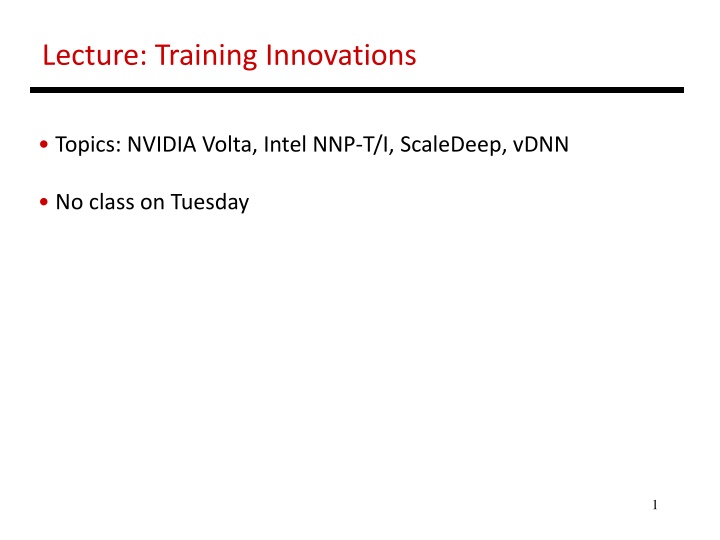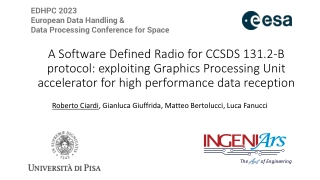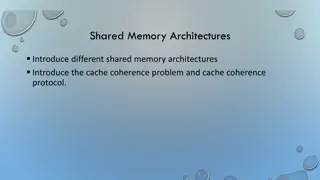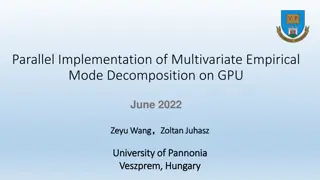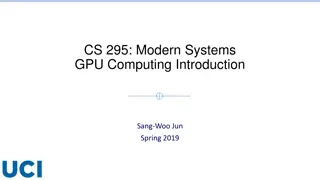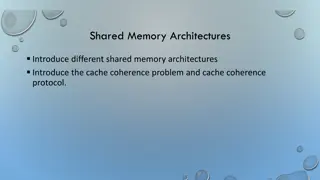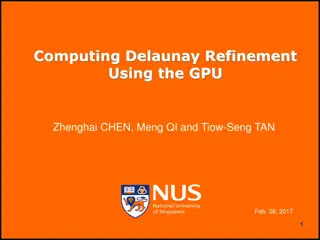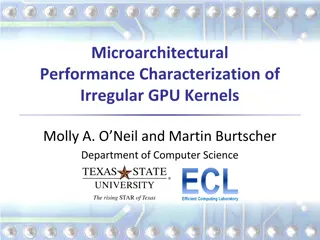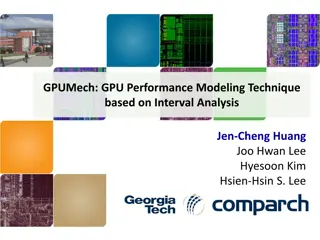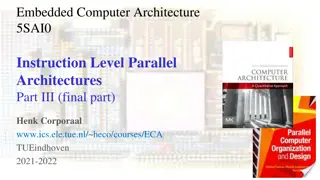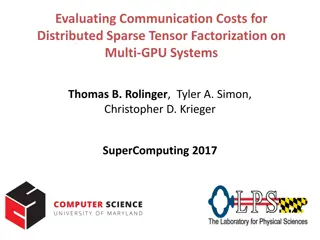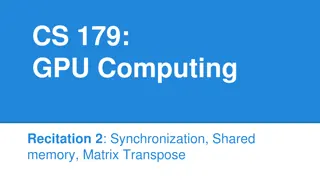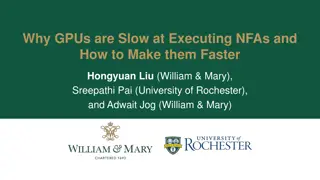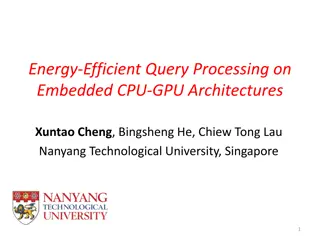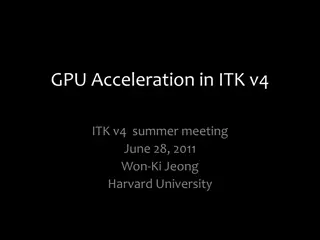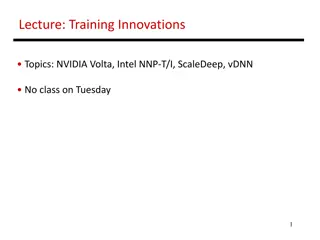Cutting-Edge Training Innovations in GPU Architectures
Uncover the latest advancements in GPU architectures from NVIDIA Volta to Intel NNP-T/I, ScaleDeep, and vDNN. Dive into the details of NVIDIA Volta's tensor cores, Intel NNP-T's Tensor Processing Cluster, NNP-I's Inference Compute Engines, and the training methodologies behind these innovative technologies. Explore the paradigm shifts in deep learning training methods, scalability enhancements, and performance optimizations.
Download Presentation

Please find below an Image/Link to download the presentation.
The content on the website is provided AS IS for your information and personal use only. It may not be sold, licensed, or shared on other websites without obtaining consent from the author.If you encounter any issues during the download, it is possible that the publisher has removed the file from their server.
You are allowed to download the files provided on this website for personal or commercial use, subject to the condition that they are used lawfully. All files are the property of their respective owners.
The content on the website is provided AS IS for your information and personal use only. It may not be sold, licensed, or shared on other websites without obtaining consent from the author.
E N D
Presentation Transcript
Lecture: Training Innovations Topics: NVIDIA Volta, Intel NNP-T/I, ScaleDeep, vDNN No class on Tuesday 1
NVIDIA Volta GPU 640 tensor cores Each tensor core performs a MAC on 4x4 tensors Throughput: 128 FLOPs x 640 x 1.5 GHz = 125 Tflops FP16 multiply operations 12x better than Pascal on training and 6x better on inference Basic matrix multiply unit 32 inputs being fed to 64 parallel multipliers; 64 parallel add operations 2 Reference: http://images.nvidia.com/content/volta-architecture/pdf/volta-architecture-whitepaper.pdf
Intel NNP-T 3 Image Source: Intel presentation HotChips 19
Intel NNP-T Each Tensor Processing Cluster (TPC) has two 32x32 MAC grids supporting bfloat16 (appears similar to TPU) Conv engine to marshall data before each step 60MB on-chip SRAM (2.5MB scratchpad per TPC) Communication is key: grid network among TPCs, 64 SerDes lanes (3.6 Tb/s) for inter-chip communication, 4 HBMs Relatively low utilization for GeMM (< 60%) and Conv (59-87%) 4 Image Source: Intel presentation HotChips 19
Intel NNP-I 12 Inference Compute Engines (ICE) that can work together or independently; 24MB central cache and 4MB per ICE Each ICE has 4K 8b MAC unit 10W, 48 TOPs, 3600 inf/s 5 Image Source: Intel presentation HotChips 19
Training Take-Homes Create a mini-batch which is a random set of training inputs; apply the fwd pass; compute error; backprop the errors (while using a transpose of weights); compute the deltas for all the weights (using the Xs of previous layer); aggregate the deltas and update the weights at the end of the mini-batch; keep creating mini-batches until you run out of training samples; this is one epoch. On the fwd pass, we use inputs X and weights W to compute output Y On the bwd pass, we use dY and weights W to compute dX; we also use dX and X to compute dW X X,W Y dY,W,X dY dX 6 dW
ScaleDeep Intro Pays attention to training (network, storage) Introduces heterogeneity Uses a spatial pipeline (instead of time-multiplexed execution) Heavy use of batching for efficiency Novel interconnect structure (for a 1.4 KW server) that helps with batching and training 7
Layer Breakdown High neuron reuse; Many feature maps; 80% of all computations High weight reuse; Large feature maps Large memory; High bytes/flop Note: FP, BP, WG 8
CompHeavy Tile Kernels enter from top and down Can do two small kernels or 1 large kernel Inputs enter from left memory Accumulation happens on right Scratchpad used for partial sums Multiple lanes in each PE (can handle different kernels) 9
MemHeavy Tile Intra-chip heterogeneity Mainly used for data storage. Can compute activations and pooling. 10
ScaleDeep Chip 3 Comp tiles per Mem tile (for FP, BP, and WG) Tiles are dedicated for specific layers (like ISAAC) Latency/thruput trade-off 11
Chip Heterogeneity Tailored for FC layer 12
ScaleDeep Node Each ConvChip works on a different image. The outputs converge on the FC chip (spokes) so it can use batching. The wheel arcs are used for weight updates and for very large convs. The FC layer is split across multiple FCchips; increases batching, reduces memory, low network bw 13
Results Summary Both chips have about 50 MB capacity Convchip consumes 58 W, FCchip consumes 15 W Inference is 3x faster than training One chip-cluster (320 W, comparable to a GPU) has 5-11x speedup over the GPU 5x speedup over DaDianNao at iso-power 14
Training on GPUs GPUs have limited memory capacity (max 12 GB) When training, in addition to storing weights, we must store all the activations as they are required during backprop; plus the weight deltas In convolution layers, the activations consume way more memory than the weights; convolution activations also have longer reuse distance than classifier weights vDNN is a runtime that automatically moves activations to CPU memory and back, so the network fits in GPU memory (avoids constrained network, multi GPUs, small batches, slower algos) 15
Motivation I 16
Motivation III Can use frequency-domain FFT algorithms that are faster, but need additional workspace 18
vDNN Proposal Runtime system that, during fwd pass, initiates an off-load of a layer s X while it is computing on X (no races because X is read-only) The layer waits if the offload hasn t finished; trying to optimize memory capacity During back-prop, initiate a prefetch of X for previous layer; must wait if prefetch hasn t finished 19
System Parameters Baseline: NVIDIA Titan X; 7 TFLOP/s; 336 GB/s GDDR5 memory bandwidth, 12 GB, 16 GB/s PCIe link for GPU CPU memory transfers Baseline with performance features (more memory reqd) vDNNall: all layers perform an offload/prefetch (least memory) vDNNconv: only convolutional layers perform offload/prefetch vDNNdyn: explores many configs to identify the few layers that need to be offloaded/prefetched, and the few layers that can use the faster algos; exploration isn t expensive and uses a greedy algorithm 20
Memory Interference Early layers need the most offloading and will interfere the most with GDDR access; but early layers also have the least memory accesses for weights; at most, the interference will be 16/336 = 5% 21
Performance Results The largest benchmark has 18% perf loss; others are near zero Dynamic scheme gives best perf while fitting in memory Power increase of 1-7% 22
References Neural Networks and Deep Learning, (Chapter 2) Michael Nielsen SCALEDEEP: A Scalable Compute Architecture for Learning and Evaluating Deep Networks, S. Venkataramani et al., ISCA 2017 vDNN: Virtualized Deep Neural Networks for Scalable, Memory- Efficient Neural Network Design, M. Rhu et al., MICRO 2016 23
